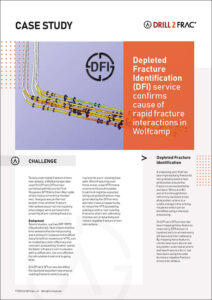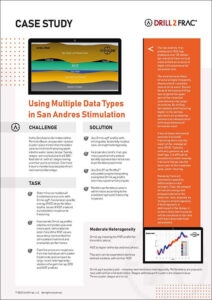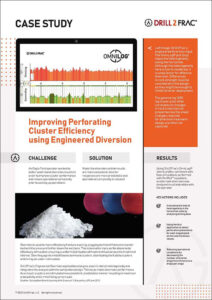Industry Papers
Authors: Kevin Wutherich, Brian Sinosic, Erica Coenen, Drill2Frac
This paper explores using drilling data to identify depleted fractures and gain valuable insights into industry models. It discusses how plotting depletion across a well pad helps calibrate fracture models by showing fracture length distribution at varying distances from parent wells. It also reveals how this information guides well spacing guidelines and unveils the impact of well spacing on depletion in child wells.
Authors: Katura Brady, Brian Atwell, Joseph Becerril, Tom Johnston, Kevin Wutherich (SG Interests, ShearFRAC, Drill2Frac)
Our client-authored paper showcases the successful application of cutting-edge data-centric technologies in mitigating fracture-driven interactions in the Southern Delaware Basin. SG Interests achieved remarkable results by utilizing techniques like Drill2Frac’s rock profiling and localized depletion detection. By proactively optimizing cluster placement and monitoring fracture pressures and response in real-time with ShearFRAC, they effectively minimized negative impacts. This approach not only maximized infill assets development within the field but also benefited both parent and child wells.
Are you interested in strategies to optimize cluster placement for maximum commercial value in the development of new wells? This URTeC 2022 paper highlights a strategy used by a Delaware Basin operator to mitigate around existing depleted fractures using near-wellbore rock properties and proactive depleted fracture identification data.
It is well known that pre-existing fractures and depletion play an integral role in the completion and production of infill wells. However, it is often left to speculation as to where and how these depleted fractures are distributed along the wellbore. To bring additional context to this problem, this paper will discuss a case study in which three complementary technologies were used to gain better understanding.
In previous frac designs, proppant tracer logs revealed poor proppant distribution between clusters. In this study, various technologies were utilized to improve cluster efficiency, primarily focusing on selecting perforations in like-rock, adjusting perforation designs and the use of diverters. Effectiveness of the changes was analyzed using proppant tracer.
This paper describes a novel process that uses standard drilling data obtained during the drilling of an infill well to identify induced hydraulic fractures that were created during the stimulation of a legacy well.
This paper presents a new analytical workflow that combines the use of drilling-derived rock properties and fracture treatment responses to gain important insights and drive future decisions for both the drilling and completion processes.
More…
This paper presents a new analytical workflow that combines the use of drilling-derived rock properties and fracture treatment responses to gain important insights and drive future decisions for both the drilling and completion processes.
More…
Apply lessons learned which can be applied to further improve economics and effectiveness of diverters in horizontal shale plays.
Case Studies
Depleted Fracture Identification
This Wolfcamp operator used Drill2Frac’s DFI service in combination with Volume to First Response (VFR) measurements to determine whether fracture interactions were possible with existing wells. The solution identified a significant number of fractures the operator was then able to avoid when planning the fracture treatment in nearby wells.
Multiple Data Types
An operator in the San Andres needed to optimize cluster placement in the transition zone to minimize fracture growth into the water zones below. Drill2Frac utilized a combination of OmniLog® to identify rock-strength heterogeneity, incorporate mud-gas mass spectrometry data and PerfAct™ flow simulation to successfully position perforation clusters with like rocks.
Engineered Diversion
Drill2Frac’s Engineered Diversion application combines OmniLog® lateral profile with PerfAct™ flow simulation to create a solution that resulted in 88% successful diversion drops on this customer well. Also, the number of screen-outs were just one-third compared to results in two offset wells that did not use the Drill2Frac solution.




![onepetro.org-URTECONF-proceedings-abstract-300x154[1]](https://drill2frac.com/wp-content/uploads/2022/01/onepetro.org-URTECONF-proceedings-abstract-300x1541-1.png)
![spe-196189-200x103[1]](https://drill2frac.com/wp-content/uploads/2022/01/spe-196189-200x1031-1.jpg)
![spe-194357-200x102[1]](https://drill2frac.com/wp-content/uploads/2022/01/spe-194357-200x1021-1.jpg)
![spe-191600-200x102[1]](https://drill2frac.com/wp-content/uploads/2022/01/spe-191600-200x1021-1.jpg)
![spe-189827-200x102[1]](https://drill2frac.com/wp-content/uploads/2022/01/spe-189827-200x1021-1.jpg)


